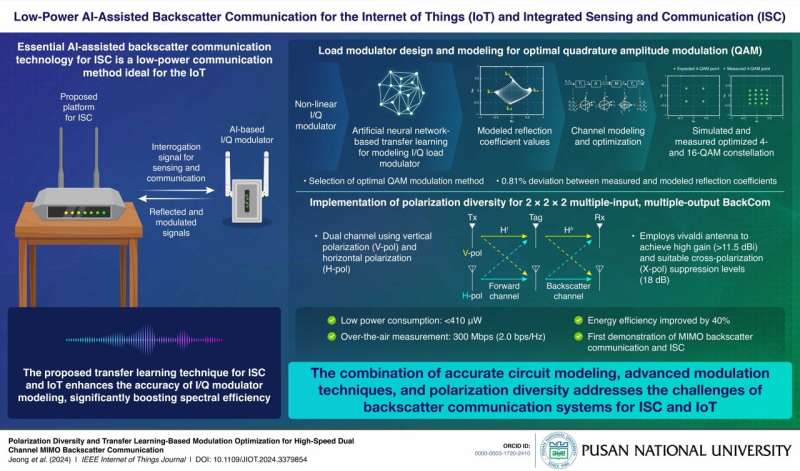July 9, 2024
Editors' notes
This article has been reviewed according to Science X's editorial process and policies. Editors have highlighted the following attributes while ensuring the content's credibility:
fact-checked
peer-reviewed publication
trusted source
proofread
A backscatter communication technique for low-power internet of things communication

Backscatter communication (BackCom) is a promising low-power method for the widespread adoption of the Internet of Things (IoT) technologies, where connected devices reflect and modulate existing signals by altering their load impedance, rather than generating signals themselves.
To achieve low bit error rates and high data rates, higher-order modulation schemes such as Quadrature Amplitude Modulation (QAM) are selected based on accurately modeled reflection coefficients. However, discrepancies between simulations and real-world measurements make it challenging to accurately predict the optimal reflection coefficient.
In a recent study, a research team led by Professor Sangkil Kim from the Department of Electronics Engineering at Pusan National University used transfer learning to accurately model the in-phase/quadrature or I/Q load modulators. Additionally, they introduced polarization diversity to design a BackCom system that utilizes multiple antennas for simultaneous signal transmission and reception.
Their paper is published in the IEEE Internet of Things Journal.
"As the technology for more efficient and reliable backscatter communication improves, it lowers the barrier for IoT adoption across numerous industries. This could lead to a proliferation of IoT devices and integrated sensing and communication (ISC), facilitating smart cities, more efficient industries, and enhanced personal and public services," says Prof. Kim.
Transfer learning involves applying knowledge gained from one task to enhance performance on a related task. The researchers pretrained an artificial neural network (ANN) using simulated input bias voltages (VI and VQ). This initial training step familiarized the ANN with the load modulator behaviors across varying voltage conditions.
The knowledge gained from the pretraining step was then used in a main training step, where the ANN was trained using experimental data to predict reflection coefficients based on VI and VQ inputs.
This transfer of knowledge enabled the ANN to improve its predictions, achieving a minimal deviation of only 0.81% between modeled and measured reflection coefficients. Using these accurate models, researchers selected optimal 4- and 16-QAM schemes by aligning predicted reflection coefficients with specific points in the QAM constellation. This optimization ensured energy-efficient data transmission, with total consumption below 0.6 mW, much lower than conventional wireless systems.
Following this, the researchers designed a 2 × 2 × 2 MIMO transceiver system for BackCom, featuring two transmit and two receive antennas with different polarizations (such as vertical and horizontal). This setup enhances signal reception, throughput, and efficiency in BackCom. Utilizing a dual-polarized Vivaldi antenna, the team achieved a high gain exceeding 11.5 dBi and effective cross-polarization suppression of 18 dB.
The researchers tested their algorithm and MIMO BackCom system in the 5.725 GHz to 5.875 GHz C-band of the Industrial, Scientific, and Medical band, offering a 150 MHz bandwidth. Their approach achieved a spectral efficiency of 2.0 bps/Hz using 4-QAM modulation, demonstrating effective bandwidth utilization. They also attained an error vector magnitude of 9.35%, indicating high reliability and efficiency in data transmission.
"The combination of accurate circuit modeling, advanced modulation techniques, and polarization diversity, all tested in over-the-air environments, presents a holistic approach to tackling the challenges in ISC and IoT," says Prof. Kim.
Overall, the proposed system lays the groundwork for a highly reliable and efficient backscatter system for multiple applications, including consumer electronics, health care monitoring, smart infrastructure for urban management, environmental sensing, and even radar communication.
More information: Hyunmin Jeong et al, Polarization Diversity and Transfer Learning-Based Modulation Optimization for High-Speed Dual Channel MIMO Backscatter Communication, IEEE Internet of Things Journal (2024). DOI: 10.1109/JIOT.2024.3379854
Journal information: IEEE Internet of Things Journal Provided by Pusan National University Citation: A backscatter communication technique for low-power internet of things communication (2024, July 9) retrieved 9 July 2024 from https://techxplore.com/news/2024-07-backscatter-communication-technique-power-internet.html This document is subject to copyright. Apart from any fair dealing for the purpose of private study or research, no part may be reproduced without the written permission. The content is provided for information purposes only.
Explore further
A novel 640 Gbps chipset paves the way for next generation wireless systems shares
Feedback to editors










